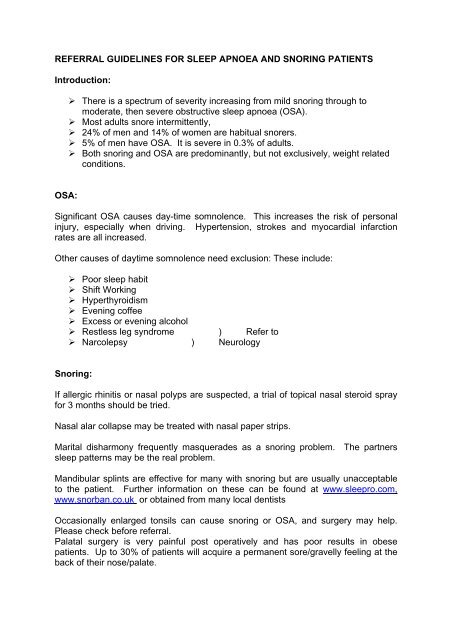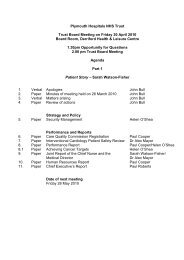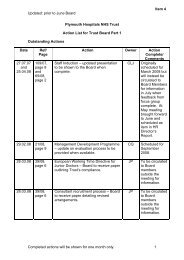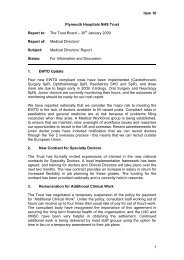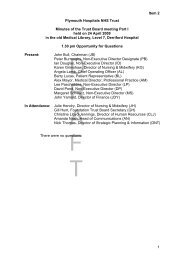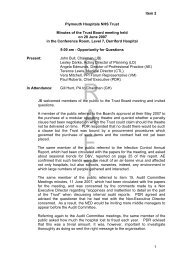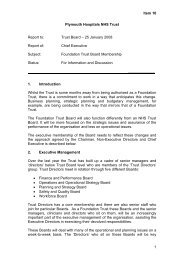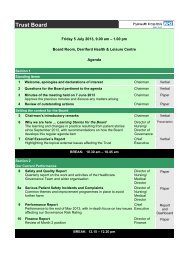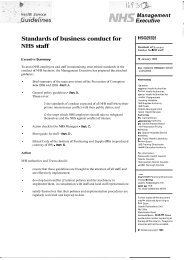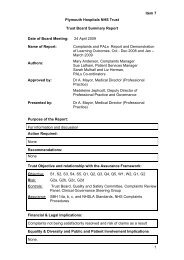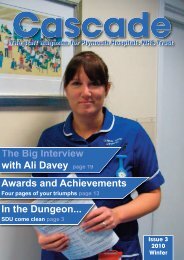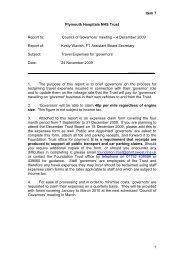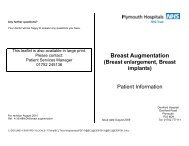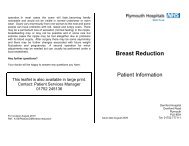referral guidelines for sleep apnoea and snoring patients - Plymouth ...
referral guidelines for sleep apnoea and snoring patients - Plymouth ...
referral guidelines for sleep apnoea and snoring patients - Plymouth ...
You also want an ePaper? Increase the reach of your titles
YUMPU automatically turns print PDFs into web optimized ePapers that Google loves.
REFERRAL GUIDELINES FOR SLEEP APNOEA AND SNORING PATIENTS<br />
Introduction:<br />
‣ There is a spectrum of severity increasing from mild <strong>snoring</strong> through to<br />
moderate, then severe obstructive <strong>sleep</strong> <strong>apnoea</strong> (OSA).<br />
‣ Most adults snore intermittently,<br />
‣ 24% of men <strong>and</strong> 14% of women are habitual snorers.<br />
‣ 5% of men have OSA. It is severe in 0.3% of adults.<br />
‣ Both <strong>snoring</strong> <strong>and</strong> OSA are predominantly, but not exclusively, weight related<br />
conditions.<br />
OSA:<br />
Significant OSA causes day-time somnolence. This increases the risk of personal<br />
injury, especially when driving. Hypertension, strokes <strong>and</strong> myocardial infarction<br />
rates are all increased.<br />
Other causes of daytime somnolence need exclusion: These include:<br />
‣ Poor <strong>sleep</strong> habit<br />
‣ Shift Working<br />
‣ Hyperthyroidism<br />
‣ Evening coffee<br />
‣ Excess or evening alcohol<br />
‣ Restless leg syndrome ) Refer to<br />
‣ Narcolepsy ) Neurology<br />
Snoring:<br />
If allergic rhinitis or nasal polyps are suspected, a trial of topical nasal steroid spray<br />
<strong>for</strong> 3 months should be tried.<br />
Nasal alar collapse may be treated with nasal paper strips.<br />
Marital disharmony frequently masquerades as a <strong>snoring</strong> problem. The partners<br />
<strong>sleep</strong> patterns may be the real problem.<br />
M<strong>and</strong>ibular splints are effective <strong>for</strong> many with <strong>snoring</strong> but are usually unacceptable<br />
to the patient. Further in<strong>for</strong>mation on these can be found at www.<strong>sleep</strong>ro.com,<br />
www.snorban.co.uk or obtained from many local dentists<br />
Occasionally enlarged tonsils can cause <strong>snoring</strong> or OSA, <strong>and</strong> surgery may help.<br />
Please check be<strong>for</strong>e <strong>referral</strong>.<br />
Palatal surgery is very painful post operatively <strong>and</strong> has poor results in obese<br />
<strong>patients</strong>. Up to 30% of <strong>patients</strong> will acquire a permanent sore/gravelly feeling at the<br />
back of their nose/palate.
Nasal pathology needs exclusion. Look <strong>for</strong>:<br />
‣ Nasal polyps<br />
‣ Allergic rhinitis<br />
‣ Deviated nasal septum<br />
WHEN AND WHERE TO REFER:<br />
Prior to <strong>referral</strong> the above differential diagnoses should be considered <strong>and</strong><br />
exacerbating factors such as obesity, alcohol, night sedation <strong>and</strong> smoking should be<br />
corrected.<br />
1. Snoring only: Do not refer to secondary care unless nasal pathology<br />
indicated.<br />
2. Significant OSA: Refer to the Chest Clinic after addressing risk<br />
factors.<br />
3. Hyper somnolence: Refer to Neurology.<br />
PRIOR TO REFERRAL PLEASE CONSIDER THE FOLLOWING:<br />
OSA<br />
The available treatments <strong>for</strong> OSA are CPAP or m<strong>and</strong>ibular splints. (Surgical<br />
treatments have unpredictable results. It is possible that they might make the use of<br />
CPAP more difficult).<br />
These treatments are only suitable <strong>for</strong> moderate <strong>and</strong> severe cases, where<br />
somnolence is significantly affecting lifestyle.<br />
Patients usually only tolerate the treatment if they have sufficient somnolence to<br />
impact on their quality of life. The degree of somnolence that warrants treatment is<br />
there<strong>for</strong>e, determined by the patient <strong>and</strong> their lifestyle. The Epworth score is a<br />
helpful measure, scores less than 12 are normal, 14 or more suggests moderate –<br />
severe OSA. (See sample questionnaire).<br />
Occasional nocturnal <strong>apnoea</strong>s may cause alarm to the <strong>sleep</strong>ing partner but if the<br />
frequency is low then there will be no ensuing daytime somnolence <strong>and</strong> no need to<br />
treat. Reassurance without <strong>referral</strong> is sufficient.<br />
Mild or occasional symptoms of OSA do not require <strong>referral</strong>, as it is unlikely that<br />
treatment will be accepted. There is no evidence of long-term health risk <strong>for</strong> this<br />
group.<br />
Review of risk factors often leads to improvement, particularly obesity <strong>and</strong> alcohol<br />
excess. (Trials of Orlistat or Sibutramine are recommended together with dietary <strong>and</strong><br />
lifestyle advice)
It is vital that <strong>patients</strong> with daytime somnolence sufficient to impair driving, or<br />
the use of machinery, are told to cease immediately, pending treatment. This<br />
particularly applies to bus <strong>and</strong> lorry drivers who should be signed off <strong>and</strong><br />
referred urgently.<br />
THE EPWORTH SLEEPINESS SCALE<br />
How likely are you to doze off or fall a<strong>sleep</strong> in the following situations in contrast to<br />
just feeling tired? This refers to your usual way of life in recent times. Even if you<br />
have not done some of these things, try to work out how they would have affected<br />
you.<br />
Use the following scale to choose the most appropriate number <strong>for</strong> each situation.<br />
0 = would never doze<br />
1 = slight chance of dozing<br />
2 = moderate chance of dozing<br />
3 = high chance of dozing<br />
Situation<br />
Chance of Dozing<br />
Sitting <strong>and</strong> reading<br />
Watching TV<br />
_______________<br />
________________<br />
Sitting inactive in a public place (eg a theatre or a meeting) ________________<br />
As a passenger in a car <strong>for</strong> an hour without a break<br />
________________<br />
Lying down to rest in the afternoon when circumstances permit<br />
Sitting <strong>and</strong> talking to someone<br />
________________<br />
________________<br />
Sitting quietly after a lunch without alcohol<br />
In a car, while stopped <strong>for</strong> a few minutes in traffic<br />
________________<br />
________________<br />
TOTAL (max. 24)


